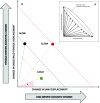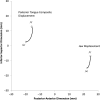Tongue- and Jaw-Specific Contributions to Acoustic Vowel Contrast Changes in the Diphthong /ai/ in Response to Slow, Loud, and Clear Speech
- PMID: 29067400
- PMCID: PMC5945076
- DOI: 10.1044/2017_JSLHR-S-17-0114
Tongue- and Jaw-Specific Contributions to Acoustic Vowel Contrast Changes in the Diphthong /ai/ in Response to Slow, Loud, and Clear Speech
Abstract
Purpose: This study sought to determine decoupled tongue and jaw displacement changes and their specific contributions to acoustic vowel contrast changes during slow, loud, and clear speech.
Method: Twenty typical talkers repeated "see a kite again" 5 times in 4 speech conditions (typical, slow, loud, clear). Speech kinematics were recorded using 3-dimensional electromagnetic articulography. Tongue composite displacement, decoupled tongue displacement, and jaw displacement during /ai/, as well as the distance between /a/ and /i/ in the F1-F2 vowel space, were examined during the diphthong /ai/ in "kite."
Results: Displacements significantly increased during all 3 speech modifications. However, jaw displacements increased significantly more during clear speech than during loud and slow speech, whereas decoupled tongue displacements increased significantly more during slow speech than during clear and loud speech. In addition, decoupled tongue displacements increased significantly more during clear speech than during loud speech. Increases in acoustic vowel contrast tended to be larger during slow speech than during clear speech and were predominantly tongue-driven, whereas those during clear speech were fairly equally accounted for by changes in decoupled tongue and jaw displacements. Increases in acoustic vowel contrast during loud speech were smallest and were predominantly tongue-driven, particularly in men.
Conclusions: Findings suggest that task-specific patterns of decoupled tongue and jaw displacement change and task-specific patterns of decoupled tongue and jaw contributions to vowel acoustic change across these speech modifications. Clinical implications are discussed.
Figures






Similar articles
-
Tongue- and Jaw-Specific Articulatory Changes and Their Acoustic Consequences in Talkers With Dysarthria due to Amyotrophic Lateral Sclerosis: Effects of Loud, Clear, and Slow Speech.J Speech Lang Hear Res. 2020 Aug 10;63(8):2625-2636. doi: 10.1044/2020_JSLHR-19-00309. Epub 2020 Jul 22. J Speech Lang Hear Res. 2020. PMID: 32697631 Free PMC article.
-
Tongue- and Jaw-Specific Articulatory Underpinnings of Reduced and Enhanced Acoustic Vowel Contrast in Talkers With Parkinson's Disease.J Speech Lang Hear Res. 2019 Jul 15;62(7):2118-2132. doi: 10.1044/2019_JSLHR-S-MSC18-18-0192. Epub 2019 Jul 15. J Speech Lang Hear Res. 2019. PMID: 31306611 Free PMC article.
-
Kinematics of Loud, Soft, and Whispered Speech.Folia Phoniatr Logop. 2024;76(5):491-500. doi: 10.1159/000536001. Epub 2024 Feb 20. Folia Phoniatr Logop. 2024. PMID: 38359809
-
Kinematic and Acoustic Changes to Vowels and Diphthongs in Bite Block Speech.J Speech Lang Hear Res. 2021 Jun 4;64(6):1794-1801. doi: 10.1044/2021_JSLHR-20-00630. Epub 2021 May 12. J Speech Lang Hear Res. 2021. PMID: 33979206
-
Effects of speaking rate, loudness, and clarity modifications on kinematic endpoint variability.Clin Linguist Phon. 2019;33(6):570-585. doi: 10.1080/02699206.2019.1566401. Epub 2019 Jan 22. Clin Linguist Phon. 2019. PMID: 30668156 Free PMC article.
Cited by
-
Identification of Mandarin Tones in Loud Speech for Native Speakers and Second Language Learners.Behav Sci (Basel). 2025 Aug 5;15(8):1062. doi: 10.3390/bs15081062. Behav Sci (Basel). 2025. PMID: 40867418 Free PMC article.
-
Articulatory and Vocal Fold Movement Patterns During Loud Speech in Children With Cerebral Palsy.J Speech Lang Hear Res. 2024 Feb 12;67(2):477-493. doi: 10.1044/2023_JSLHR-23-00411. Epub 2024 Jan 16. J Speech Lang Hear Res. 2024. PMID: 38227476 Free PMC article.
-
A first investigation of tongue, lip, and jaw movements in persons with dysarthria due to multiple sclerosis.Mult Scler Relat Disord. 2019 Jan;27:188-194. doi: 10.1016/j.msard.2018.10.116. Epub 2018 Oct 30. Mult Scler Relat Disord. 2019. PMID: 30399501 Free PMC article.
-
Articulatory Performance in Dysarthria: Using a Data-Driven Approach to Estimate Articulatory Demands and Deficits.Brain Sci. 2022 Oct 20;12(10):1409. doi: 10.3390/brainsci12101409. Brain Sci. 2022. PMID: 36291342 Free PMC article.
-
Detection of Articulatory Deficits in Parkinson's Disease: Can Systematic Manipulations of Phonetic Complexity Help?J Speech Lang Hear Res. 2020 Jul 20;63(7):2084-2098. doi: 10.1044/2020_JSLHR-19-00245. Epub 2020 Jun 29. J Speech Lang Hear Res. 2020. PMID: 32598198 Free PMC article.
References
-
- Carstens Medizinelektronik GmbH. (2014). CalcPos. [Computer Software]. Bovenden, Germany: AG501.
-
- Carstens Medizinelektronik GmbH. (2014). NormPos. [Computer Software]. Bovenden, Germany: AG501.
-
- Chung H., Kong E. J., Edwards J., Weismer G., & Fourakis M. (2012). Cross-linguistic studies of children's and adult's vowel spaces. The Journal of the Acoustical Society of America, 131(1), 442–454. https://doi.org/10.1121/1.3651823 - PMC - PubMed
-
- Connaghan K., & Patel R. (2017). The impact of contrastive stress on vowel acoustics and intelligibility in dysarthria. Journal of Speech, Language, and Hearing Research, 60(1), 38–50. https://doi.org/10.1044/2016_JSLHR-S-15-0291 - PMC - PubMed
-
- Darling M., & Huber J. E. (2011). Changes to articulatory kinematics in response to loudness cues in individuals with Parkinson's disease. Journal of Speech, Language, and Hearing Research, 54, 1247–1259. https://doi.org/10.1044/1092-4388(2011/10-0024) - PMC - PubMed
Publication types
MeSH terms
Grants and funding
LinkOut - more resources
Full Text Sources
Other Literature Sources
Miscellaneous

